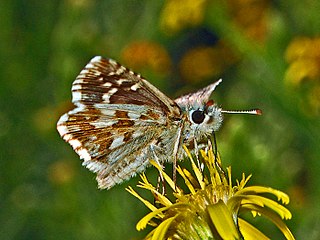
Helianthemum, known as rock rose, sunrose, rushrose, or frostweed, is a genus of about 110 species of flowering plants in the family Cistaceae. They are widely distributed throughout the Northern Hemisphere, especially in the Mediterranean.

Helianthemum apenninum, the white rock-rose, is a white-flowering rock rose of the family Cistaceae found in the North Atlantic region, mainly in dry grassy and rocky places across large parts of Europe.

Helianthemum nummularium is a species of rock-rose (Cistaceae), native to most of Europe.

The rosy grizzled skipper is a species of skipper.

Cerocala sana is a moth of the family Erebidae first described by Otto Staudinger in 1901. It is found in North Africa, Iran, Iraq, Bahrain and Israel.
Parafomoria helianthemella is a moth of the family Nepticulidae. It is found in central and southern Europe, including Germany, south-eastern Poland, the Czech Republic, Slovakia, Hungary, Austria, Switzerland, northern Italy, France and Bulgaria.
Sherburn Hill is a Site of Special Scientific Interest in County Durham, England. It lies just south of the road between the villages of Sherburn and Sherburn Hill, some 5.5 km east of Durham city. A disused quarry occupies part of the site.
Coleophora bilineella is a moth of the family Coleophoridae. It is found in southern Europe.
Coleophora eupreta is a moth of the family Coleophoridae. It is found in France, Spain, Portugal, Italy and North Macedonia.

Coleophora ochrea is a moth of the family Coleophoridae found in Europe. It was first described by Adrian Hardy Haworth in 1828.
Adscita capitalis is a moth of the family Zygaenidae. It is found in North Macedonia, Greece and Turkey.

Anacampsis scintillella is a moth of the family Gelechiidae. It is found in most of Europe, except Ireland, Great Britain, the Netherlands, Norway, Finland, most of the Baltic region and Poland.

Mompha miscella is a moth in the family Momphidae, found in Asia Minor, Europe and North Africa.

Hypochalcia ahenella is a species of snout moth in the genus Hypochalcia. It was described by Michael Denis and Ignaz Schiffermüller in 1775 and is known from most of Europe, Turkey, and Texas in the US.

Selagia argyrella is a species of snout moth. It is found in almost all of Europe, except Ireland, Norway, Finland, Estonia, Ukraine and Portugal. In the east, the range extends to Asia.
Mecyna trinalis is a species of moth in the family Crambidae. It is found in France, Spain, Italy, Austria, the Czech Republic, Slovakia, Poland, Hungary, the Balkan Peninsula, Ukraine, Russia, Turkey and North Africa, including Algeria and Morocco.
Pyropteron affine is a moth of the family Sesiidae. It is found in most of Europe, except Ireland, Great Britain, the Netherlands, Denmark, Fennoscandia, the Baltic region, Poland and Bulgaria. It is also found in Asia Minor, Georgia, the Middle East and North Africa.

Mesophleps silacella, the straw crest, is a moth of the family Gelechiidae. It is found in Europe, Turkey and Algeria.
Mesophleps corsicella is a moth of the family Gelechiidae. It is found in Spain, Portugal, France and Italy, Greece and on Corsica, Sardinia and Sicily. Outside of Europe, it is found in Morocco and Lebanon.
Scythris fuscoaenea is a moth of the family Scythrididae found in Europe.










